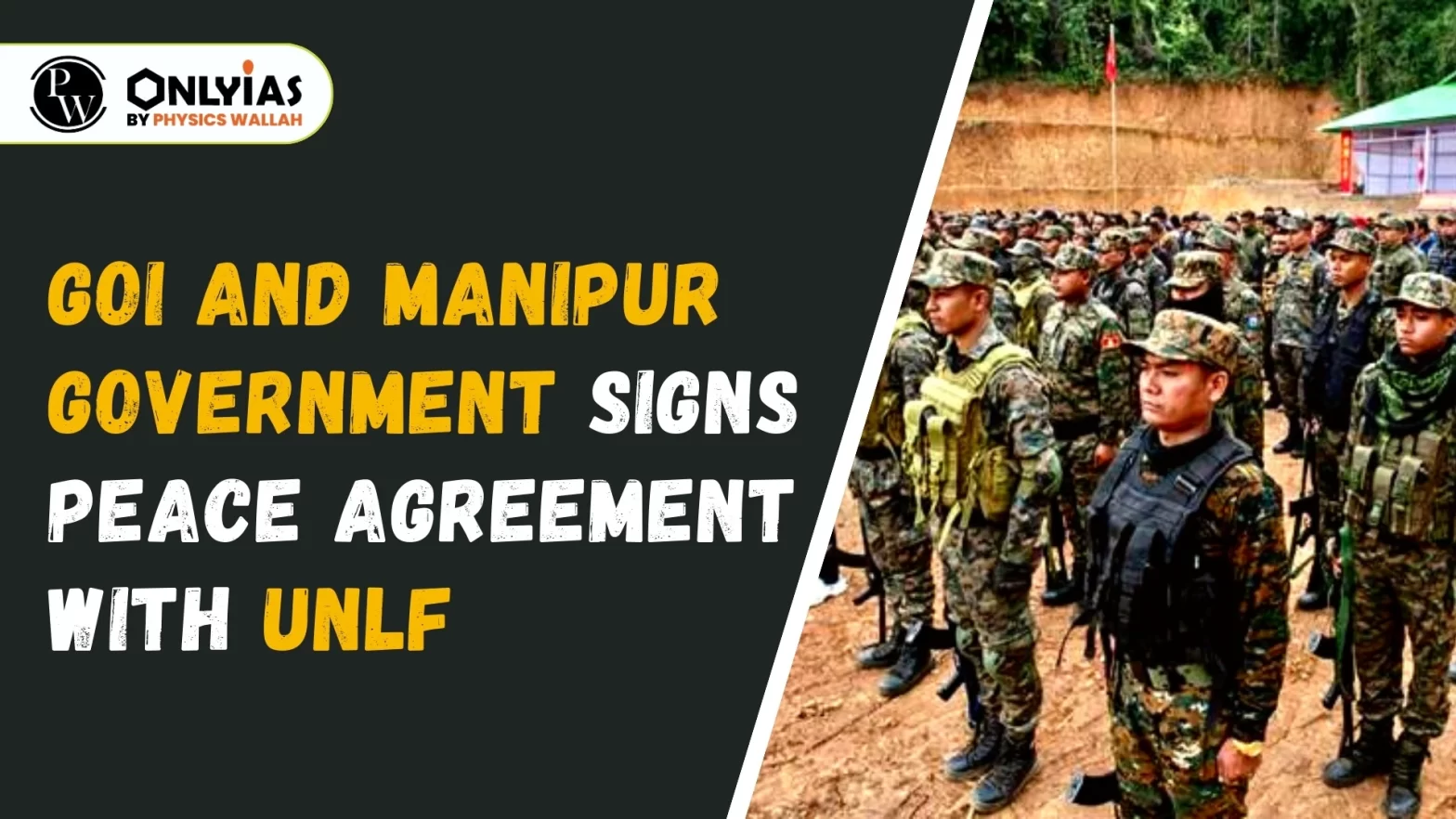Context: This article is based on an Editorial “Manipur: UNLF faction says peace talks with govt a death trap, betrayal of people” which was published in the economic times. Recently, the Union and Manipur governments signed a peace agreement with UNLF (United National Liberation Front).
| Relevancy for Prelims: United National Liberation Front (UNLF), Meitei Extremist Organizations, Manipuri Armed Groups, Manipur Peoples’ Army (MPA), Meitei, Kuki, Zomi, and Naga, Communities, Unlawful Activities (Prevention) Act 1967, Armed Forces Special Powers Act (AFSPA), and Bodoland Territorial Council.
Relevancy for Mains: Peace Agreement With UNLF (United National Liberation Front) in Manipur highlights the sustained efforts in conflict resolution. |
What is the significance of the signed peace agreement with UNLF?
- Ending Hostilities: The agreement will cease hostilities between UNLF and security forces.
- Constitution of Peace Monitoring Committee (PMC): To oversee the enforcement of the rules.
- Factions Joining Agreement: The peace pact has been joined by around 65 cadres of one of the factions of the UNLF, led by K. Pambei.
- Historic Transition: For the first time, a valley-based Manipuri armed group has agreed to return to the mainstream by abjuring violence and agreeing to honor the Constitution of India.
- Reduction in Violence: The central government has signed peace agreements with several northeastern insurgents/rebels, enabling a decline of 73% in violent incidents, 72% in fatalities of security forces, and 86% in civilian killings during 2014-23.
What is the UNLF?
- Genesis: The UNLF was formed in 1964 seeking Manipur’s secession from India and has been operating both within and outside Indian territory.
- Meitei Extremist Organizations: It is declared unlawful associations under the Unlawful Activities (Prevention) Act 1967.
|
What are the reasons behind the rise of insurgency in Manipur?
- Demand for an Independent State by the militant organizations.
- Spillover Effect from Nagaland.
- Emergence of Kuki Insurgent Groups in reaction to Naga aggression against the Kukis.
- Emergence of Smaller Insurgent groups such as Zeliangrong United Front (ZUF), People’s United Liberation Front (PULF) and other splinter groups.
What factors contributed to the rise of insurgency in Manipur?
- The Policy Polarisation: As Kuki-Zo and Naga communities can buy land in the valley, but the Meiteis cannot buy land in the hills.
- Ethnic Cleansing: The region has seen multiple inter-ethnic conflicts — Kuki-Naga, Meitei-Muslim, Kuki-Karbi, Hmar-Dimasa, and even Kuki-Tamil clashes.
- Racial Discrimination: Hate crimes against people from Northeast India in metros are treated as isolated incidents and they are neglected in policy discourse.
- Influx of Refugees: The rise of Meitei nationalism and insurgency has been influenced by the influx of refugees from Myanmar.
- Development Deficit: Underdevelopment of tribal districts are also a reason for insurgency.
- Other Factors: Government actions, including crackdowns on poppy cultivation in the hill districts and addressing “illegal settlements” in these areas is another factor behind insurgency.
What are the impacts of insurgency?
- Provocation of anti-national sentiments by various groups on various occasions such as August 15th or January 26th.
- Influencing Public Opinion, as observed in the previous Assembly election, the KNO president instructed voters to support the BJP and significantly swayed the electorate in favor of the party.
- Deterioration of Law and Order creates concerns of fringe elements becoming active.
- Shelter to Illegal Refugees, due to the fear of persecution in their country by the military junta.
What measures has the government implemented to counter insurgency?
- Imposition of Armed Forces Special Powers Act (AFSPA): In 1980, the Centre declared Manipur a “disturbed area” and imposed AFSPA to suppress the insurgency movement.
- Suspension of Operation (SoO) Agreement: Various peace talks led to a tripartite SoO agreement between the Centre, the state, and the Kuki-Zomi groups in 2008.
- Ceasefire Agreement: In 1997, it was agreed between the Centre and the NSCN-IM.
- Suspension of Operation (SoO) Pact: It was signed on August 22, 2008 by the Kuki outfits with the Centre and Manipur Government.
Way Forward:
- Prevention of insurgent activities by strict vigilance.
- Voluntary Surrender related concerted and deliberate operations must be launched.
- Enroll and Invite the Youth for Talks to ensure Manipur returns to normalcy faster.
- A Collaborative Approach by various stakeholders to restore normalcy in Manipur.
- Unified Command structure is required to bring Manipur out of the state of insurgency.
- Border management with Myanmar, especially for illegal immigration and drug menace.
- Integrated development policy with a consensus among various tribes of the region.
Conclusion:
The recent peace agreement with UNLF (United National Liberation Front) in Manipur marks a significant step towards ending hostilities, fostering historic transitions, and reducing insurgency-related violence, underlining the need for sustained collaborative efforts in conflict resolution.
![]() 5 Dec 2023
5 Dec 2023

